Birdfinding.info ⇒ Despite long-term declines, each form of Rose-throated Parrot remains locally common in portions of its original range. The “Bahama Parrot” can be found on Abaco around Marsh Harbour, Bahama Palm Shores, Sandy Point, and Abaco National Park, and throughout Great Inagua, including Matthew Town. A small, likely introduced flock on New Providence is seen mostly in downtown Nassau east to Montagu Bay. The “Cuban Parrot” is most reliably found in the Zapata Swamp area at Playa Larga, Soplillar, and Bermejas Wildlife Refuge. Other areas where it is still seen regularly include Topes de Collantes and Alejandro de Humboldt National Parks. The “Cayman Parrot” is readily found on Grand Cayman at Botanic Park and the Mastic Trail, and on Cayman Brac in the Brac Parrot Reserve.
Rose-throated Parrot
Amazona leucocephala
Endemic to the West Indies: the Bahamas; Cuba and its satellites; and the Cayman Islands. Comprises three distinct forms that may represent multiple species:
“Bahama Parrot” (bahamensis): remnant populations on Abaco and Great Inagua. Formerly also on Acklin, but extirpated in the early 1900s. In 2016 the Abaco population was estimated at 3,000 to 5,000, and the Inagua population 8,000 to 13,000. A small flock that appeared on New Providence in the early 2000s may be either introduced or conceivably a natural recolonization from Abaco.

Approximate distribution of the Rose-throated Parrot (“Bahama”, “Cuban”, and “Cayman” forms). © BirdLife International 2020
“Cuban Parrot” (leucocephala): Cuba, the Isle of Youth and the Jardines del Rey Archipelago, in various types of woodlands. Formerly occurred throughout, but a history of persecution as a cagebird commodity has reduced its numbers and distribution. In 2020 the total population was estimated in the range of 7,000 to 14,000, mostly in the Zapata Swamp region, but also in many small remnant flocks scattered from the Guanahacabibes Peninsula to the Isle of Youth and the Sierra Cristal.
“Cayman Parrot” (caymanensis, plus hesterna): Grand Cayman and Cayman Brac, in dry forests. Populations have been estimated at approximately 1,900 on Grand Cayman and 450 on Cayman Brac. Extirpated from Little Cayman.
Identification
A large Amazona parrot with variable amounts of white on the crown and pink on the throat. The nominate Cuban form is roughly intermediate in appearance between the outlying Bahama and Cayman forms.
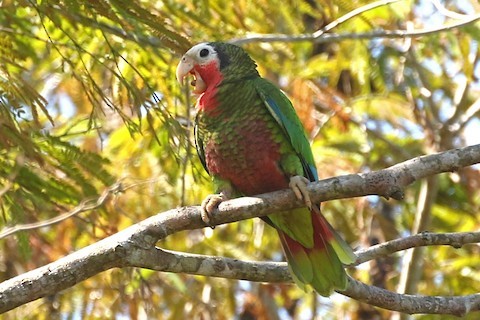
“Cuban Parrot”, A. l. leucocephala. (Bermejas Wildlife Refuge, Matanzas, Cuba; March 17, 2020.) © Jeffrey Offermann
“Cuban Parrot”. Prominent features include a white forecrown and face, pale bill, and pink bib that extends from the cheeks and throat down onto the chest.
The head, neck, back, and chest have a dark, scaly appearance because the feathers are partly green with variably broad blackish tips, typically darkest around the ear.
The belly is variably infused with maroon, which is also present on the underside of the tail at the base of the outer feathers.
The upperside of the wing is mostly bluish. The underside usually appears mostly green with a black tip and trailing edge.
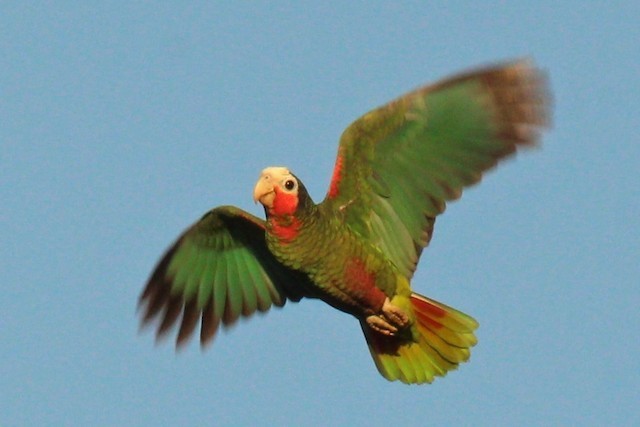
“Cuban Parrot”, A. l. leucocephala, ventral view in flight, showing maroon on belly and base of outer tail feathers. (Bermejas Wildlife Refuge, Matanzas, Cuba; December 8, 2016.) © Jason Estep
“Bahama Parrot”. Similar to the Cuban form overall, but averages more extensive white on the head and more extensive pink on the throat, often extending onto the chest. Unlike the other forms, “Bahama” rarely if ever shows maroon on the belly (but sometimes has a few pinkish-red belly feathers, extending down from the chest).
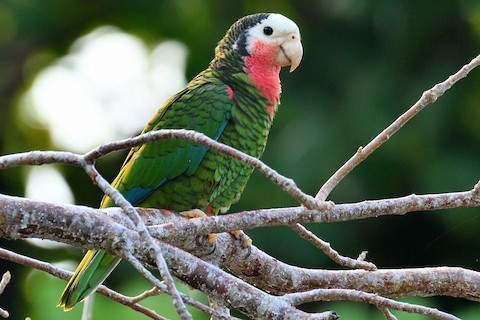
“Bahama Parrot”, A. l. bahamensis—note extensive white on the cheek and pink on the chest, and absence of maroon on the belly. (Bahama Palm Shores, Abaco, Bahamas; April 18, 2021.) © John Doty
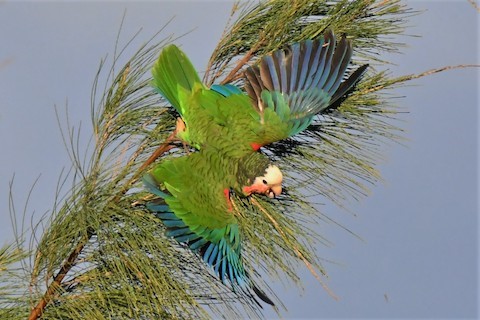
“Bahama Parrot”, A. l. bahamensis, taking flight and showing blue on the uppersides of the wings. (Cherokee, Abaco, Bahamas; January 6, 2018.) © Christopher Johnson
“Cayman Parrot”. Similar to the Cuban form overall, but with much less white on the head (mostly confined to the forehead), and averages patchier, less extensive pink on the throat. Usually shows a dark ear patch and some maroon on the belly.
The two subspecies overlap in plumage characteristics, but hesterna of Cayman Brac is somewhat smaller and averages more colorful on the face and belly than caymanensis of Grand Cayman.
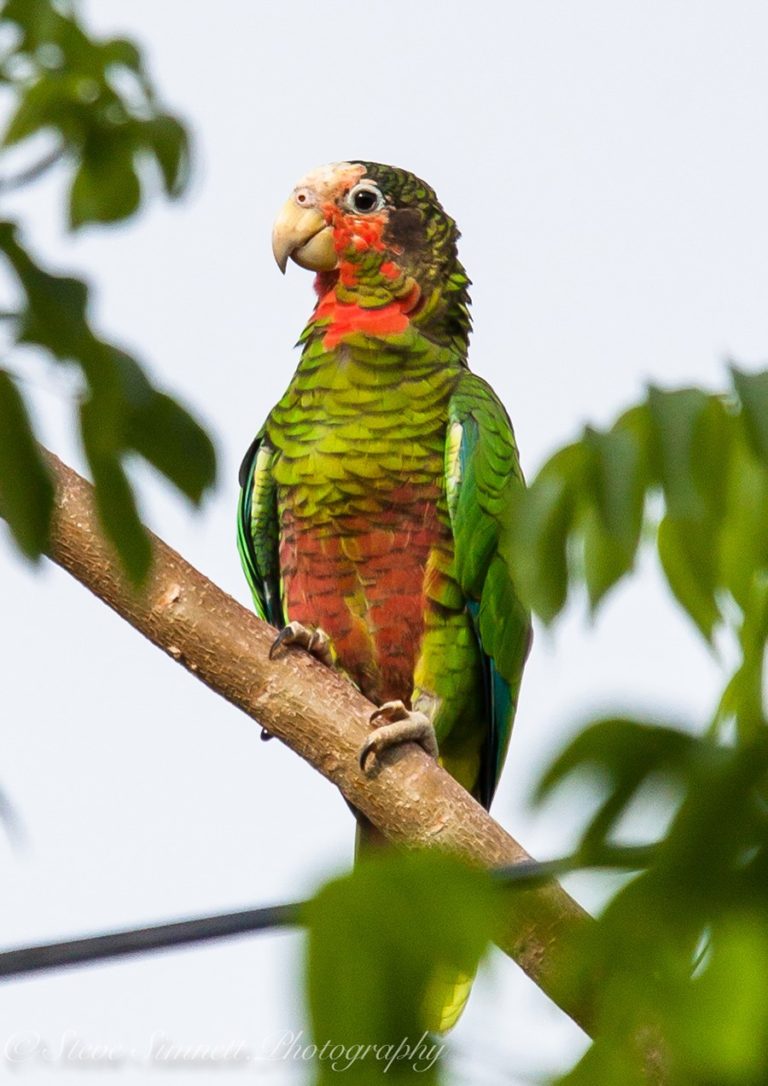
“Cayman Parrot,” A. l. hesterna, showing patchy pink on the throat and extensive maroon on the belly. (Cayman Brac.) © Steve Simnett
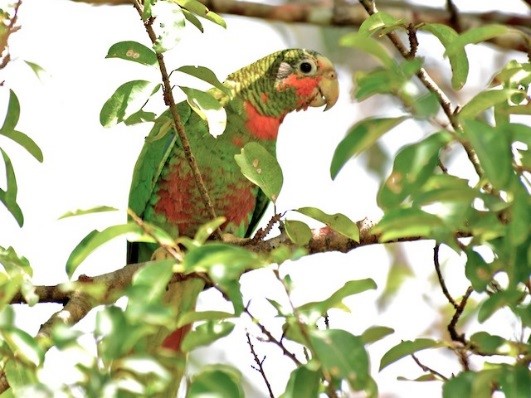
“Cayman Parrot,” A. l. caymanensis, showing patchy pink on the throat and maroon on the belly. (Grand Cayman; March 19, 2013.) © Alan Van Norman

“Cayman Parrot”, A. l. hesterna, showing the extensive blue on its upperwing. (Christopher Columbus Park, Cayman Brac; March 9, 2021.) © Nicole Martin
Notes
Polytypic species consisting of four recognized subspecies that are subdivided into three distinct forms: the “Bahama Parrot” (bahamensis); “Cuban Parrot” (leucocephala); and “Cayman Parrot” (caymanensis and hesterna). The combined species is usually referred to collectively as the Cuban Parrot, but it makes sense to reserve the geographical tag for use when differentiating the forms as distinct, potentially separate species. Raffaele et al. (1998) instead adopt the name Rose-throated Parrot, which seems clearly preferable as it avoids the ambiguity and emphasizes the most prominent feature that the forms share in common.
IUCN Red List Status: Near Threatened.
References
BirdLife International. 2020. Amazona leucocephala. The IUCN Red List of Threatened Species 2020: e.T22686201A179212864. https://dx.doi.org/10.2305/IUCN.UK.2020-3.RLTS.T22686201A179212864.en. (Accessed March 9, 2022.)
Bond, J. 1979. Birds of the West Indies (Fourth Edition). Collins, London.
eBird. 2022. eBird: An online database of bird distribution and abundance. Cornell Lab of Ornithology, Ithaca, N.Y. http://www.ebird.org. (Accessed March 9, 2022.)
Forshaw, J.M. 2010. Parrots of the World. Princeton University Press, Princeton, N.J.
Juniper, T., and M. Parr. 1998. Parrots: A Guide to Parrots of the World. Yale University Press.
Kirwan, G.M., A. Levesque, M. Oberle, and C.J. Sharpe. 2019. Birds of the West Indies. Lynx Edicions, Barcelona.
Raffaele, H., J. Wiley, O. Garrido, A. Keith, and J. Raffaele. 1998. A Guide to the Birds of the West Indies. Princeton University Press.
Xeno-Canto. 2022. Cuban Amazon – Amazona leucocephala. https://xeno-canto.org/species/Amazona-leucocephala. (Accessed March 9, 2022.)
